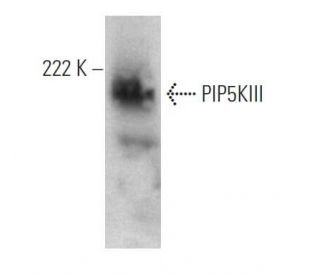
PIP5KIII Antibody (64-Q6): sc-100408
- PIP5KIII Antibody (64-Q6) is a mouse monoclonal IgG2a κ PIP5KIII antibody, cited in 11 publications, provided at 100 µg/ml
- raised against amino acids 342-452 mapping within an internal region of PIP5KIII of human origin
- recommended for detection of PIP5KIII of mouse, rat and human origin by WB, IP, IF, IHC(P) and ELISA
- m-IgG Fc BP-HRP and m-IgG2a BP-HRP are the preferred secondary detection reagents for PIP5KIII Antibody (64-Q6) for WB and IHC(P) applications. These reagents are now offered in bundles with PIP5KIII Antibody (64-Q6) (see ordering information below).
QUICK LINKS
SEE ALSO...
PIP5KIII Antibody (64-Q6) is a mouse monoclonal IgG2a kappa light chain antibody that detects PIP5KIII protein of mouse, rat, and human origin by western blotting (WB), immunoprecipitation (IP), immunofluorescence (IF), immunohistochemistry with paraffin-embedded sections (IHCP), and enzyme-linked immunosorbent assay (ELISA). Anti-PIP5KIII antibody (64-Q6) is available as the non-conjugated form. PIP5KIII protein, also known as Phosphatidylinositol 3-phosphate 5-kinase, FAB1, CFD, PIKFYVE, or ZFYVE29, is a crucial enzyme that synthesizes phosphatidylinositol-3,5-bisphosphate by catalyzing the phosphorylation of phosphatidylinositol 3-phosphate at the fifth hydroxyl of the inositol ring. This phosphorylation is vital for various cellular processes, including the regulation of cytoskeletal functions, membrane trafficking, and receptor signaling, as this activity facilitates the recruitment of protein complexes to cell and endosomal membranes. PIP5KIII is composed of 2,098 amino acids and features a DEP domain, a FYVE-type zinc finger, and a PIPK domain, which are essential for function and interactions within the cell. Notably, PIP5KIII exists as four alternatively spliced isoforms, allowing for diverse functional roles in cellular dynamics. Defects in the gene encoding PIP5KIII are associated with corneal fleck dystrophy, an autosomal disorder characterized by the presence of small white flecks throughout the corneal stroma, highlighting PIP5KIII′s significance in maintaining cellular integrity and function.
Alexa Fluor® is a trademark of Molecular Probes Inc., OR., USA
LI-COR® and Odyssey® are registered trademarks of LI-COR Biosciences
PIP5KIII Antibody (64-Q6) References:
- Phosphatidylinositol 3-phosphate-interacting domains in PIKfyve. Binding specificity and role in PIKfyve. Endomenbrane localization. | Sbrissa, D., et al. 2002. J Biol Chem. 277: 6073-9. PMID: 11706043
- PIKfyve controls fluid phase endocytosis but not recycling/degradation of endocytosed receptors or sorting of procathepsin D by regulating multivesicular body morphogenesis. | Ikonomov, OC., et al. 2003. Mol Biol Cell. 14: 4581-91. PMID: 14551253
- Hypertonic stress increases phosphatidylinositol 4,5-bisphosphate levels by activating PIP5KIbeta. | Yamamoto, M., et al. 2006. J Biol Chem. 281: 32630-8. PMID: 16943196
- The mammalian phosphatidylinositol 3-phosphate 5-kinase (PIKfyve) regulates endosome-to-TGN retrograde transport. | Rutherford, AC., et al. 2006. J Cell Sci. 119: 3944-57. PMID: 16954148
- The phosphoinositide kinase PIKfyve mediates epidermal growth factor receptor trafficking to the nucleus. | Kim, J., et al. 2007. Cancer Res. 67: 9229-37. PMID: 17909029
- PIKfyve: Partners, significance, debates and paradoxes. | Shisheva, A. 2008. Cell Biol Int. 32: 591-604. PMID: 18304842
- Elevated levels of PtdIns5P in NPM-ALK transformed cells: implication of PIKfyve. | Coronas, S., et al. 2008. Biochem Biophys Res Commun. 372: 351-5. PMID: 18501703
- Loss of PIP5KIbeta demonstrates that PIP5KI isoform-specific PIP2 synthesis is required for IP3 formation. | Wang, Y., et al. 2008. Proc Natl Acad Sci U S A. 105: 14064-9. PMID: 18772378
- PIKfyve regulation of endosome-linked pathways. | de Lartigue, J., et al. 2009. Traffic. 10: 883-93. PMID: 19582903
- A novel PIKFYVE mutation in fleck corneal dystrophy. | Kotoulas, A., et al. 2011. Mol Vis. 17: 2776-81. PMID: 22065932
- Production of phosphatidylinositol 5-phosphate via PIKfyve and MTMR3 regulates cell migration. | Oppelt, A., et al. 2013. EMBO Rep. 14: 57-64. PMID: 23154468
- PIP5KIβ selectively modulates apical endocytosis in polarized renal epithelial cells. | Szalinski, CM., et al. 2013. PLoS One. 8: e53790. PMID: 23342003
Ordering Information
| Product Name | Catalog # | UNIT | Price | Qty | FAVORITES | |
PIP5KIII Antibody (64-Q6) | sc-100408 | 100 µg/ml | $333.00 | |||
PIP5KIII Antibody (64-Q6): m-IgG Fc BP-HRP Bundle | sc-539689 | 100 µg Ab; 10 µg BP | $354.00 | |||
PIP5KIII Antibody (64-Q6): m-IgG2a BP-HRP Bundle | sc-546753 | 100 µg Ab; 10 µg BP | $354.00 |
